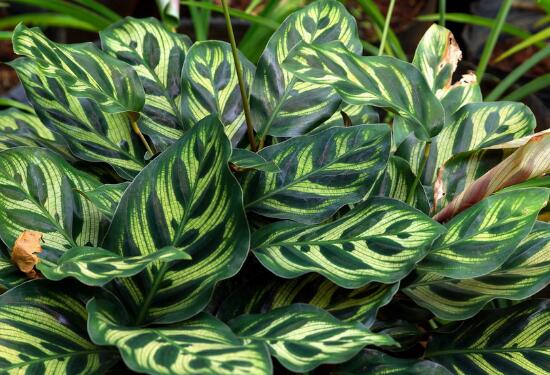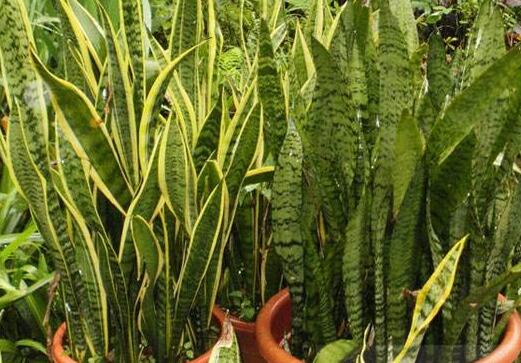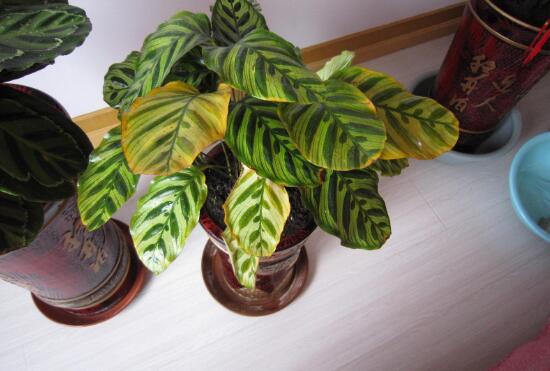How to do yellow arrowroot leaves, control watering, proper fertilization/reasonable light is the key
As a common foliage plant, the beauty of taro is mostly reflected in its leaves, so when its leaves turn yellow, it will seriously affect the ornamental nature of taro. At this time, the flower friends must be in a hurry. What about the yellowing of taro leaves? In this regard, the editor summarized the reasons for the yellowing of 6 kinds of taro leaves, and attached remedial measures, come in and have a look!
First, the leaves of bamboo taro turn yellow, find the reason.

Bamboo taro is easy to raise, but the plants that are easy to raise do not mean that there will be no problems. In daily life, many of the flower lovers who raise taro are novice. They usually do not follow the cultivation method of taro. As a result, yellow leaves appear. In such a situation, flower friends must be very worried, but don't worry, because after the leaves of taro turn yellow, as long as remedial measures are taken, taro can still be saved.
Second, the causes and remedial measures of yellowing of bamboo taro leaves.
1. Environmental mutation
There are many reasons for the yellowing of taro leaves, the first thing that comes to mind is the environment, which can be divided into two situations: one is the newly bought taro, because the environment has changed greatly, and the taro cannot adapt temporarily, resulting in leaf yellowing symptoms; the second is to put the taro in a poor air environment, or air conditioning changes, which will also lead to the emergence of yellow leaves.
The remedy: understand the growing environment before the taro is bought, and then we change it to a similar environment at home, and after a period of time, the plant will return to health. If it is caused by the poor indoor environment, it is very simple to improve the environment. To put it simply, clean up the garbage and move the flowerpot to the ventilated place.
2. Improper lighting
① light is too strong: bamboo taro avoid strong light direct light, once the strong sunlight on the bamboo taro leaves, it is easy to cause flowers leaf tip, leaf edge withered, the sunrise part of the leaves appear macula. Remedy: simply move the flowerpot to the shade.
Lack of ② light: although bamboo taro likes semi-shade, there is also a demand for light. Once it is in a shady environment for a long time, its leaves can not form chlorophyll because they do not get enough sunlight, so there will be symptoms of yellowing of taro leaves. Remedy: supplement the light, but be careful that the light is not too strong.
3. Improper watering
① overwatering: bamboo taro likes the wet environment, in the breeding process, should frequently watering to keep the basin soil moist. But watering too much can not, this will cause taro leaves yellowing, its performance is: young leaves dark yellow and no luster, old leaves have no obvious change. Remedy: put the flowers out of the pot in a cool, ventilated place, let the moisture evaporate quickly, and then put it back in the basin.
② watering too little: taro water demand is large, once too little watering, will also cause the emergence of yellow leaves, its performance is: old leaves withered and yellow shedding from bottom to top, but the growth of new leaves is relatively normal. Remedy: appropriate amount of watering, sufficient watering and thorough watering.
4. Excessive fertilization
In addition to improper lighting and watering, excessive fertilization is also one of the reasons for the yellowing of taro leaves. Its performance is as follows: the new leaf tip appears dry brown, and the concave and convex does not stretch, and the old leaf is scorched yellow and falls off.
Remedy: if it is caused by excessive fertilization of taro leaves yellowing, we should immediately stop fertilization; in serious cases, wash the soil of the flowerpot in time to remove the excess fertilizer. When cleaning, we should also ensure that the drainage of the basin soil is good, so as not to cause stagnant water to rot the roots.
Generally speaking, bamboo taro is very easy to raise, but because many flower friends are novices, it is inevitable that there will be symptoms of leaf yellow. However, after reading the full text, I believe you have a bottom in your mind, and the Ye Huang problem can be remedied in accordance with the above methods. With regard to the yellowing of bamboo taro leaves, the editor has introduced this, hoping to give you some help.
How do peacock bamboo taro leaves turn yellow? controlling watering, proper fertilization / light is the key.
As a beautiful foliage plant, the beauty of peacock taro is mainly reflected in its leaves, so when its leaves turn yellow, its ornamental will decline sharply. At that time, the flower friends must be in a hurry. What if the peacock taro leaves turn yellow? In this regard, the editor summarized the reasons for the yellowing of 6 kinds of peacock bamboo taro leaves, and attached remedial measures, come in and have a look!
First, the peacock bamboo taro leaves turn yellow, find the reason.
The culture method of peacock taro is very simple, but because there are many novices, they often have negligence in the process of breeding, resulting in yellow leaves, thus affecting the ornamental nature of the plant. As for the peacock taro leaves yellow how to do, we just need to calm down to find the source of the disease, and take remedial measures, peacock taro can still be saved.
Second, the causes and remedial measures of the yellowing of peacock bamboo taro leaves.
1. Environmental mutation
There are many reasons for the yellowing of peacock bamboo taro leaves, and the first thing that comes to mind is the environment. Because nowadays, many flower friends' peacock bamboo taro potted plants are bought online, which may lead to great changes in the environment, plants can not adapt for a while, resulting in leaf yellow symptoms.
Remedy: it is very simple, the root store asked about the growth environment of peacock taro before, and then we changed it to the same environment at home, and after a period of time, the plant will return to health.
2. Improper lighting
① light is too strong: Peacock bamboo taro avoid strong light direct light, once the strong sunlight on the peacock bamboo taro leaves, it is easy to cause flowers leaf tip, leaf edge withered, the sunrise part of the leaves appear macula. Remedy: do not need too much treatment, move to a cool place in time; if yellowing is more serious, remove the leaves directly.
Lack of ② light: peacock taro likes a semi-shady environment, but if it is placed in a shady environment for a long time, its leaves can not get enough sunlight to form chlorophyll, there will be symptoms of yellowing of peacock taro leaves. Remedy: supplement the light, but be careful that the light is not too strong.
3. Improper watering
Too much ① watering: Peacock bamboo taro likes wet environment, but too much watering can not, which will cause peacock bamboo taro leaves yellowing, its performance is: young leaves are dark yellow and no gloss, old leaves have no obvious change. Remedy: take off the plant, bask in the sun, wait for the pot soil to dry and replant, and then pay attention to watering the right amount.
② watering too little: peacock taro needs a lot of water, once too little watering, it will also cause the emergence of yellow leaves, its performance is: old leaves withered and yellow shedding from bottom to top, but the growth of new leaves is relatively normal. Remedy: pay attention to watering enough and thoroughly.
4. Improper fertilization
Excessive fertilization in ①: in addition to improper light and watering, excessive fertilization is also one of the reasons for the yellowing of peacock bamboo taro leaves. Its performance is as follows: the new leaf tip appears dry brown, and the concave and convex does not stretch, and the old leaf is scorched yellow and falls off. Remedy: stop fertilizing and flush the soil of the flowerpot in time to remove the excess fertilizer.
Insufficient fertilization in ②: too much fertilizer is not good, but the lack of fertilizer in peacock taro is not good, which will inevitably lead to poor growth. Its performance is as follows: the color of the young leaves becomes lighter, showing yellow or light green, while the old leaves are more normal or gradually change from green to yellow. Remedy: usually apply thin fertilizer frequently and pour some alum water at the right time, and apply nitrogen fertilizer.
Generally speaking, peacock taro is easy to raise, but because many flower friends are novice, it is inevitable to have the symptom of leaf yellow. However, after reading the full text, I believe you have a bottom in your mind, and the Ye Huang problem can be remedied in accordance with the above methods. With regard to the yellowing of peacock bamboo taro leaves, the editor has introduced this, hoping to bring help to everyone.
What if the leaves of double-line bamboo taro turn yellow, suitable for light / reasonable water and fertilizer / spraying for diseases and insect pests
As a common foliage plant, the leaves of double-line taro are rich in color, which are equal to white, green and red, giving people a unique visual enjoyment. But in the process of breeding, because of some reasons, its leaves will be yellow, thus affecting the overall ornamental, then double-line taro leaves yellow how to do? Today, the editor is here to solve this problem for everyone.
First, what if the leaves of the double-line taro turn yellow?
When it comes to the yellowing of double-line taro leaves, in addition to environmental discomfort, it is caused by improper maintenance: when the light is insufficient or too strong, add light or shade; water and fertilizer is inappropriate, reasonable watering and fertilization, if there are rotten roots, you should also take off the pot and cut the roots, and then change the pot soil to plant again; if it is caused by diseases and insect pests, spray in time for prevention and control.
Second, the causes and remedial measures of yellowing of double-line taro leaves.
1. Environmental mutation
As for the reason for the yellowing of double-line taro leaves, if it is a new potted plant, it may be caused by a sudden change in the environment. Because many of the flower friends' double-line taro potted plants are purchased online, it is easy to cause a big change in the environment, and the double-line taro can not adapt for a while, resulting in leaf yellow symptoms.
Remedy: according to the growth habits of double-line taro, we should create an optimal growth environment for the newly bought potted plants. after a period of time, the plant will return to health.
2. Improper lighting
Lack of light: although double-line taro is shady, it also has a demand for light. once it is in a shady environment for a long time, its leaves will turn yellow because they do not get enough sunlight to form chlorophyll. Remedy: supplement the light, but be careful that the light is not too strong.
The light is too strong: double-line taro avoid strong light, once the strong sun shines directly on its leaves, it is easy to cause flower leaf tip, leaf edge withered, leaf sunrise part of the macula. Remedy: move the flowerpot to the shade in time, wait for it to slow down, then water it properly, and then gradually move to a place with good light.
3. Improper watering
Too little watering: double-line taro likes the humid environment, daily maintenance needs frequent watering to keep the basin soil moist. Once the water is underwatered, the leaves will turn yellow because of lack of water, which shows that the old leaves wither and fall off from the bottom up, but the new leaves grow normally. Remedy: appropriate amount of watering, sufficient watering and thorough watering.
Overwatering: double-line taro likes water, but there is also a degree if it is watered too much, resulting in stagnant water in the basin, the root system will have difficulty breathing, resulting in symptoms of yellowing of double-line taro leaves. Remedy: put the double-line taro in a ventilated and cool place, let the moisture evaporate quickly, and those with rotten roots need to be cut off, and then put back into the basin.
4. Excessive fertilization
Insufficient fertilization: the leaves of double-line taro are broad and rich in color. If you want it to grow well, it is very important to apply the right amount of fertilizer. In the process of breeding, if there is not enough fertilizer, the old leaves will turn yellow because of lack of nutrients. Remedy: replenish nutrients in time, but to double-line taro fertilizer should adhere to thin fertilizer diligently.
Excessive fertilization: although double-line taro likes fertilizer, too much fertilizer will produce fertilizer damage, resulting in dry brown at the tip of the new leaves, and concave and convex not stretched, and the old leaves are scorched yellow and fall off. Remedy: immediately stop fertilizing, and then diluted with water; if the roots are burned, people should also take off the plant, cut off the rotten roots, and then replace them with new potted soil and replant them.
5. Diseases and insect pests
Except for the above points, the yellowing of double-line taro leaves may be caused by diseases and insect pests. It is understood that in the case of improper maintenance and poor environment, double-line taro may be attacked by aphids and shell insects, which mainly harm the leaves of the plant, resulting in yellow leaves.
Remedy: it is simple to identify specific pests and then control them by spraying. As for what kind of medicine should be sprayed, you can refer to the pest control of double-line taro.
Generally speaking, the culture method of double-line taro is not difficult, but because many flower friends are novice, it is inevitable to have the symptom of leaf yellow. However, after reading the full text, I believe you have a bottom in your mind, and the Ye Huang problem can be remedied in accordance with the above methods. With regard to the yellowing of double-line taro leaves, the editor has introduced this, hoping to give you some help.
- Prev

Tiger tail orchid leaves rotten how to do, six reasons make the leaves yellow rot / with a solution
We know that one of the functions and functions of the tiger tail orchid is to watch the leaves. It is also named for the tiger pattern on the leaves, but when it is cultured, it will cause the leaves to wither, yellowing or even rot for various reasons, which greatly reduces its ornamental quality.
- Next

How do peacock bamboo taro leaves turn yellow? controlling watering, proper fertilization / light is the key.
As a beautiful foliage plant, the beauty of peacock taro is mainly reflected in its leaves, so when its leaves turn yellow, its ornamental will decline sharply. At that time, the flower friends must be in a hurry. What if the peacock taro leaves turn yellow? In this regard, the editor summarized the reasons for the yellowing of the leaves of six kinds of peacock bamboo taro.
Related
- Fuxing push coffee new agricultural production and marketing class: lack of small-scale processing plants
- Jujube rice field leisure farm deep ploughing Yilan for five years to create a space for organic food and play
- Nongyu Farm-A trial of organic papaya for brave women with advanced technology
- Four points for attention in the prevention and control of diseases and insect pests of edible fungi
- How to add nutrient solution to Edible Fungi
- Is there any good way to control edible fungus mites?
- Open Inoculation Technology of Edible Fungi
- Is there any clever way to use fertilizer for edible fungus in winter?
- What agents are used to kill the pathogens of edible fungi in the mushroom shed?
- Rapid drying of Edible Fungi

